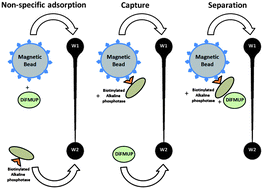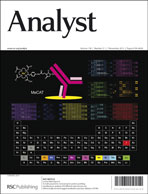Capture and separation of biomolecules using magnetic beads in a simple microfluidic channel without an external flow device
Abstract
The use of microfluidic devices and magnetic beads for applications in biotechnology has been extensively explored over the past decade. Many elaborate microfluidic chips have been used in efficient systems for biological assays. However most fail to achieve the ideal point of care (POC) status, as they require larger conventional external devices in conjunction with the microchip. This paper presents a simple technique to capture and separate biomolecules using magnetic bead movement on a microchip without the use of an external flow device. This microchip consisted of two well reservoirs (W1 and W2) connected via a tapered microchannel. Beads were dragged through the microchannel between the two wells at an equivalent speed to a permanent magnet that moved alongside the microchip. More than 95% of beads were transferred from W1 to W2 within 2 min at an average velocity of 0.7 mm s−1. Enzymatic reactions were employed to test our microchip. Specifically, three assays were performed using the streptavidin coated magnetic beads as a solid support to capture and transfer biomolecules: (1) non-specific adsorption of the substrate, 6-8-difluoro-4-methylumbelliferyl phosphate (DiFMUP), (2) capture of the enzyme, biotinylated alkaline phosphatase (AP), and (3) separation of AP from DiFMUP. Our non-specific adsorption assay indicated that the microchip was capable of transferring the beads with less than 0.002% carryover of DiFMUP. Our capture assay indicated efficient capture and transfer of AP with beads to W2 containing DiFMUP, where the transferred AP converted 100% of DiFMUP to DiFMU within 15 minutes. Our separation assay showed effective separation of AP from DiFMUP and elucidated the binding capacity of the beads for AP. The leftover unbound AP in W1 converted 100% of DiFMUP within 10 minutes and samples with less than the full bead capacity of AP (i.e. all AP was transferred) did not convert any of the DiFMUP. The immobilization of AP on the bead surface resulted in 32% reduced enzymatic speed compared to that of free AP in solution, as a result of altered protein conformation and/or steric hindrance of the catalytic site. Overall, this microfluidic platform was established as a simple, efficient and effective approach for separating biomolecules without any flow apparatus.


 Please wait while we load your content...
Please wait while we load your content...